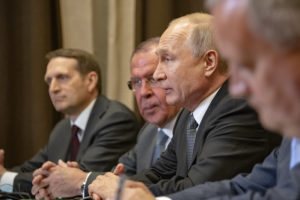
U.S. Secretary of State Michael R. Pompeo meets with Russian President Vladimir Putin in Sochi, Russia on May 14, 2019. [State Department photo by Ron Przysucha/ Public Domain]
In a sentence, we saw very little trickle down in the Russian economy. The Putin crowd has all the money. Prosperity at an upper middle-class level is nonexistent to the eye of this traveler.
As for the three Baltic countries, I like what I saw and heard in Estonia. On the other hand, Latvia and Lithuania appeared desperate, backward, dismal little countries terrified of Russia and fixated on a Cold War mentality.
Here the National Interest offers a NATO-centric update on this pretty well forgotten corner of the world:
As many people will recall, the Baltic nations of Estonia, Latvia and Lithuania, with a combined population of some six million and combined military strength of some thirty thousand active-duty troops, joined NATO in 2004. All three border Russia, though in the case of Lithuania, that border is in the western part of the country (near Russia’s Kaliningrad pocket). Lithuania’s eastern frontier is shared with Belarus, a close ally of Moscow, at Vladimir Putin’s insistence. Its southern border touches Poland, along the famed “Suwalki gap,” the narrow land corridor through which NATO would likely send most of its tens of thousands of reinforcements during any major crisis or conflict with Russia over the Baltics.
All three Baltic states, plus Poland, are now among the seven of NATO’s twenty-nine members that meet their obligations to spend at least 2 percent of gross domestic product on their militaries, however imperfect a metric of burden-sharing that formal NATO requirement may be. In Lithuania’s case, this represents a tripling of military spending since 2013.
Give President Donald Trump and President Barack Obama some of the credit for recent increases if you wish. But give the Lithuanians, Latvians, Estonians, and Poles the majority of the credit—with a nod, of course, to Vladimir Putin, who has done more to unify and motivate eastern Europeans’ security efforts than anyone else this century.
NATO needs to rethink its broader strategy towards Russia. This strategy should include options for bettering relations in a post–Putin Russia. Various types of security architectures and arrangements should be explored and debated.
Read more here.
If you’re willing to fight for Main Street America, click here to sign up for my free weekly email.




